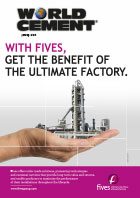Editorial comment
January is traditionally a time for looking to the future. But let me take you back into the past for just a moment – about 600 years to be precise. The Ming dynasty was continuing the construction of the Great Wall of China, which was originally begun in the 7th century BC, or thereabouts. Life had moved on somewhat in the intervening millennia, and the rammed earth and reed construction of the original walls could now be updated with more modern technology. Stones and bricks were used instead of earth and the Chinese developed a special mortar to hold it all together: a mixture of slaked lime and sticky rice. Apparently the sticky rice accounts for both the mortar’s durability and its bright white colour.
Register for free »
Get started now for absolutely FREE, no credit card required.
Facts like these amaze me. Today we are looking at the use of rice husks as an alternative fuel in cement manufacture and it seems forward-thinking. Six hundred years ago, they cooked up the rice and threw it in. Necessity is the mother of invention, I suppose. They needed a wall that would hold (pre-cement) and they built one. It makes you wonder what else we could be throwing in the mix, doesn’t it?
These days, it seems, the secret ingredient could be bacteria. Scientists at several universities are working on a specially blended self-healing concrete that contains bacteria hidden in tiny capsules. When water drains into a crack in the concrete, the bacteria is released and produces limestone, which seals up the crack. This development could mark the end of potholes – a problem that has been plaguing travellers since the invention of roads. The spending on road maintenance in a little country like the UK runs into billions of pounds annually. With the amount of repairs needed in countries with extensive road networks – the US, India – self-healing concrete would surely be a winner, not to mention it would provide another reason to choose concrete over asphalt.
We’ve got plenty more innovations in this issue. In particular, if you’re interested in alternative fuels, we have articles about solid waste fuels, tyre-derived fuels, sewage sludge and a case study from Buzzi Unicem, which is utilising a variety of wastes in its process. We’re also featuring articles looking at nuisance dust, wear and abrasion protection, additives and the latest developments in cooler technology – a little something for everyone.
Aside from technical innovations, 2015 is set to be an interesting year for the cement industry. This month will see companies make their binding bids for the assets of Lafarge and Holcim being divested as part of their merger, which is set to be finalised in the first half of this year. At the time of writing, both UltraTech Cement Ltd and Cementos Argos had withdrawn their bids for assets in Brazil, while HeidelbergCement had announced previously that it would not be making a bid for any of the assets up for sale. We will keep you updated with all the latest news on this merger and all the other activity in the cement industry at www.worldcement.com. Meanwhile, for a glimpse into the cement hot-spots for the coming year, turn to this month’s keynote article from Imran Akram of IA Cement.


